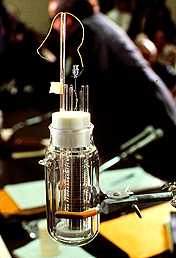
http://members.tripod.com/WWJD_GY/indexold2.html
History of Cold Fusion?

http://members.tripod.com/WWJD_GY/indexold2.html
For a short time at least, it was hard to imagine a more contentious issue in fusion research than the plausibility of cold fusion. In March of 1989, two researchers at the University of Utah, Stanley Pons and Martin Fleischmann, announced the achievement of "cold fusion," or fusion at room temperature. Their experiment used an electrochemical cell with electrodes of palladium and platinum containing a solution of heavy water (water with deuterium instead of ordinary hydrogen). When a current is passed through the cell, it breaks apart the water molecules, causing deuterium atoms to collect on the palladium surface.
Pons and Fleischmann claimed to have generated large amounts of excess heat from the fusion of the deuterium atoms that were tightly compressed together on the palladium surface.
The chemists' announcement spurred the development of several research programs in the area of cold fusion, even though no one was able to replicate their results. This led to many rebuttals against the theory of cold fusion, and the experimental procedure used by Pons and Fleischmann was thoroughly attacked. In fact, the amount of heat that they claimed to have generated should have produced enough neutrons to kill them. Some of the subsequent experiments detected a small excess of neutrons, but none approached the levels needed to "prove" cold fusion. Today, most of the scientific community worldwide dismisses cold fusion as a hoax; yet there is still significant, albeit largely "underground," research in the area.
Because cold fusion lacks credibility in the dominant scientific community, many who believe in its feasibility will embrace any supporting evidence put forth, whether or not it has scientific validity. This leads to a further degradation of the cold fusion field, making it highly unlikely that researchers in the area will find funding in the future.